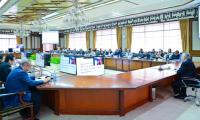Islamabad: Despite a decline in the number of paralytic cases, continuing poliovirus circulation in environmental samples remains an area of deep concern in Pakistan. The distribution of cases further accentuates the worry because each province has notified a polio case this year. Lack of a transformative solution between Afghanistan and Pakistan, as well as delay and rejection of visas for 22 external polio consultants, are added barriers to performance that could cost Pakistan its international reputation, if it contributes to an outbreak of poliovirus.
These are just four of the many gaps that Pakistan’s polio eradication programme needs to overcome, as flagged in the 15th report produced by the Independent Monitoring Board (IMB) of the Global Polio Eradication Initiative (GPEI). The report was globally released on Thursday.
“The Pakistan Polio Programme should look critically at the speed of implementation of response to the appearance of environmental-positive poliovirus samples. Rapid, comprehensive and effective action in days, not weeks, should be the golden rule. Pakistan must also overhaul visa approval arrangements so that bona de essential polio advisers and programme leaders have their visas approved in a period of days,” the IMB report states.
While IMB has repeatedly commended the strong political engagement and leadership from all levels in Pakistan, it has expressed surprised to note that the speed of action has not always been there. “The prime minister immediately decided on a Twin City Task Force in response to the situation in Islamabad and Rawalpindi, but it took some time to materialise, wasting nearly a month before something was working effectively,” the report cites as an examples.
The IMB has endorsed that Pakistan and Afghanistan continue to be regarded as one epidemiological block to secure strong cross-border arrangements for polio vaccination. “However, neither of the two countries comes to believe that continuing poliovirus circulation is due to weaknesses in the work of their counterpart. Current programme performance has not reached the level necessary to clear wild poliovirus out of either of these two endemic countries,” the report states.
The IMB has also recommended closer scrutiny of environmental samples and a very high standard delivery of time-tested polio surveillance activities, particularly in Pakistan and Afghanistan, where wild poliovirus is still actively circulating, where transformative change is not happening, and where there is still not enough evidence of organised, quality improvement programmes in areas such as micro planning, campaign effectiveness and highly mobile populations. The report also recommends hiring of the most competitive, assertive and strong area supervisors and their counterparts at the district and union council levels.
The report notes that transmission of poliovirus has been interrupted at every site in Pakistan, but never at the same time. In analysing the situation in Balochistan, the report sees Chaman in the Killa Abdullah district is being an example of one of the most high-risk areas, “Yet the poliovirus is not being steamrollered into submission there.” Since 2011, 70 per cent of polio cases in Quetta Block have been in Chaman. The document recommends for the District Commissioner for Killa Abdullah to take assertive control of the response to polio in his district, particularly the Chaman subdivision. “He should be aware that he is presiding over a jurisdiction that is one of the worst polio trouble spots in the world. He should seek to alleviate the paucity of municipal and wider health services to the poorest areas,” the report states.
The IMB sees wild poliovirus-positive isolates in Quetta Block as signifying a worrying source of ongoing transmission. “Security in Quetta Block remains volatile. Killa Abdullah was repeatedly discussed during the IMB meeting. It is one of the most challenging polio environments in the whole world. Designing a programmatic response to achieve performance excellence there seems to be defeating everyone,” the report states. Quetta Block has below 30 per cent routine immunization coverage and Balochistan overall is below 20 per cent. Whilst the priority is to reach populations with oral polio vaccine, routine immunisation can play an important part.
With reference to Karachi and wider Sindh, the report sees the re-establishment of circulation in Karachi after importation from southern Sindh and the southern corridor as a setback to the programme. Karachi was free of poliovirus for parts of 2016; then was re-infected. Now there is intense transmission. “They are attempting to track and identify the high-risk mobile populations and engage the community, which has not welcomed vaccination efforts. There are multiple factors driving resistance from the community. One is campaign fatigue. The frequency of the campaigns, especially in some of these areas, has produced a backlash. Two, the populations reacting negatively to the vaccine largely live in slum areas, where civic amenities are almost non-existent. These populations ask why such a focus on polio? Why not on other health services? Why not on other civic services which the government could provide? “the report points out. The key challenge for Karachi, according to the report, is to sustain an extremely high level of engagement, not just for this upcoming low season, but also for the countdown to certification.
A third hotspot is the twin cities of Islamabad and Rawalpindi where the virus has found a new home. Despite major efforts, the virus has stubbornly persisted among communities in these two cities. “The environmental data for Islamabad and its twin city should have led to stronger action earlier,” the report states.
Fata, which was a huge challenge for polio eradication in Pakistan three years ago, has not had a confirmed polio case for more than a year now. “The current challenge is to sustain progress,” the report recommends.
The GPEI is regularly communicating that the number of wild poliovirus cases is the lowest in history. A WHO spokesperson told the BBC in May 2016, “This is the lowest toll of cases in history. We expect to be within months of polio elimination in Pakistan”. This “almost there” narrative is perhaps not the best one to promulgate, the report states, adding “Now that interruption of transmission has not materialized 18 months after this announcement, attention must turn to the number, distribution and geographical movement of polioviruses, not simply cases.”
Whilst good progress is being made, the IMB believes that the final stage of the journey to eliminate polio transmission globally is proving extraordinarily difficult. The poliovirus is surviving despite all the good work and in the face of everything that is being thrown at it, thereby necessitating re-energisation of staff and efforts to achieve eradication.






